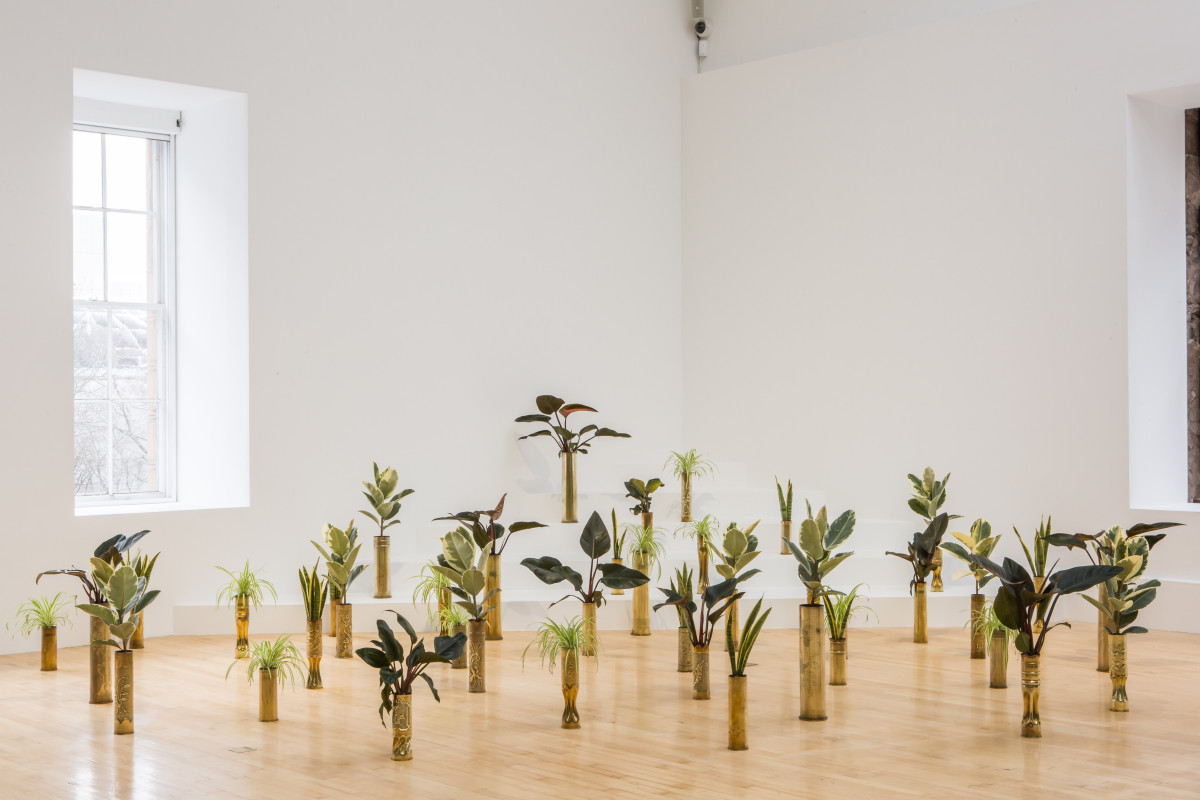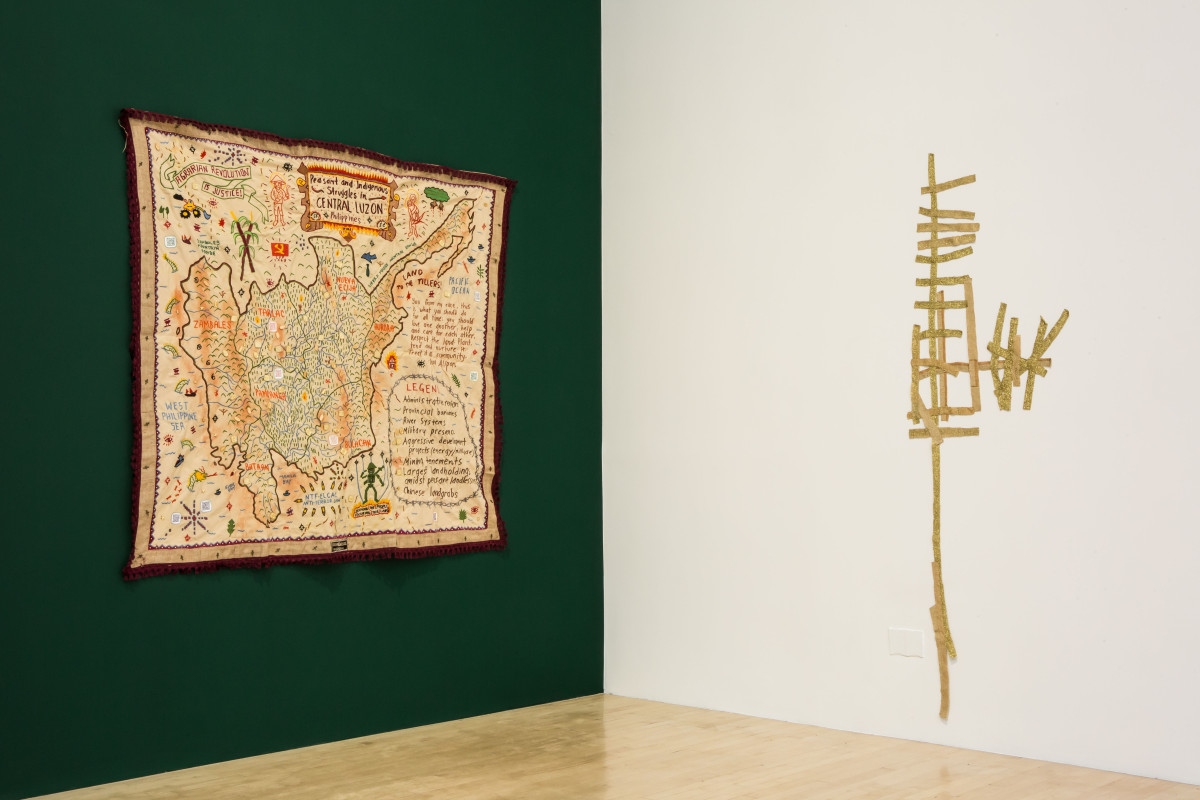The Accursed Share
-

Marwa Arsanios, Sammy Baloji, Cian Dayrit,
Moyra Davey, Hanna von Goeler, Goldin+Senneby, Lubaina Himid, Hana Miletić, terra0
Debt – the measure of what people owe – is a fundamental principle of human societies. But the history of monetary debt is one of startling violence: the sovereign figurehead on the banknotes (the “I owe you”) in your pocket is an echo of centuries of empire-building, colonisation, evictions, enslavement, exploitation of resources, and militarisation. At a time of spiralling debts and the cost of living crisis, The Accursed Share draws on the work of nine international artists and artist groups to explore this wretched system and to celebrate attempts to resist it. The works on view explore the way capitalism alters our relationship to people and nature just as they appeal to us to think about values that might transcend a form of violence so prevalent it often seems like normality.
Share
Marwa Arsanios’ film series Who Is Afraid of Ideology? looks at the global struggles of women trying to reconnect to the land and nature, spanning eco-feminists, indigenous farmers and autonomous communes. Part 4: Reverse Shot (2022) – her latest film shown at documenta 15 – is about the attempt to turn an area of land in Lebanon into a common space. Decades of colonialism, civil war and privatisation have damaged land and rights; Arsanios delineates the careful legal negotiations and forensic evaluation of the soil health that make up the profound process of resuscitation required to liberate the land.
Sammy Baloji’s Untitled (2018 / 2023) will bring 50 copper gun shells into the gallery, all potted with plants from the Katanga region of the Democratic Republic of the Congo (where the artist is from). Millions of Africans died here under the barbarous regime of King Leopold II of Belgium, and the debt owed by Belgium for the huge wealth amassed under subsequent colonial rule is the subject of the country’s recent BLM protests. For Baloji, copper from the Katanga region is symbolic of the history of African traditions being smashed by the desire to establish free trade. From those forced into labour in the mines and the extraction itself, to the role of copper and African people in two World Wars, to the current use of these gun shells as planters for bourgeoisie households – Baloji exposes and commemorates a deep-rooted injustice that still shapes global relationships.
Moyra Davey is a film-maker, photographer and writer often concerned with making art through and about the everyday. With the series Copperheads (1990 – ongoing), her meticulous attention falls to the Lincoln Cent, minted since 1909. Photographing it with a macro lens to create large, detailed colour prints, her work allows us to see the dirt, patinas and scars on these objects, whilst her system of folding and posting the work to exhibiting galleries leaves other traces of circulation and material reality. Davey stated that she was interested in the “perverse psychological paradoxes of individual relations to money” and – considering her own lack of money and the 1980s US recession – found an interesting baseness in this one-cent coin. Silent and stoic, the images seem caught between worthlessness and value, lumpen metal and state power.
Cian Dayrit makes many of his works in collaboration with indigenous and peasant communities in the Philippines (where ‘peasant’ is a term adopted by smallholders fighting for improved human rights). Sometimes taking the form of maps the works chart the historical and contemporary forms of oppression and corruption that damage so many lives. From the Dutch ‘East Indies’ and US and Chinese military manoeuvres, to the ruling elite families and multinational corporations, Dayrit and his collaborators lay bare the monsters that divide territories up into resources for exploitation and provide space for counter-mapping and the memory and language of previous peoples. Dayrit’s work shows how a system of debt requires dependency and carries powerful stories about farmers massacred for trying to grow food for their families, whilst governments squander vast fortunes.
Goldin+Senneby’s recent body of work saw them acquire land and explore the double meaning of ‘plot’ – as both a designated area and the making of a story. With The Plot (Utopia Bloemen) (2018) they acquired an area of land in Belgium on top of a former coal mine. Pushing the idea of en plein air (“outside”) painting, which takes the process of making art out of the studio and into the landscape, they centre the work on a portable box that includes the deeds to the land and a poem by Belgium’s poet Laureate, Mustafa Kör, whose father was a miner there. Finding fossils of a 350-million-year-old carboniferous forest on the plot, they produced stencils to transform coal dust into an immersive wall mural that haunts the exhibition space with an earthly excess.
Hanna von Goeler has made a number of paintings on top of defunct banknotes. The Migration series focuses on birds, which speak to nature’s traversal of human territories and to its vulnerability – with birds on the front line of the ecological crisis. Strangely beautiful in their obsolescence, the notes suggest collective visions of civilisation, statehood and value. In some cases von Goeler makes a direct political reference, for example by depicting a Syrian bird on Greek currency to signify the refugee crisis, and in others she considers the notes aesthetically to produce a new kind of evocation.
Lubaina Himid’s Naming the Money is a ground-breaking work by the Turner-prize winning artist. Through the hand-painted, cut-out figures she conjures up the enslaved Africans depicted in history paintings of the European Royal Courts. Shifting their status from anonymous signifiers of wealth, Himid bestows each the dignity of individuality. On their backs they have two names, one their own and the other given to them by their owners. As the artist states, “I wanted to create a meaningful conversation with audiences about what it means to belong, especially in the context of people who are ripped from one life into another. Whilst the work connects to various histories, its strength lies in its ability to connect; after all, each of us has a name.” It speaks to the European debt owed to the millions of people enslaved in the last centuries, whilst foregrounding a kind of vibrant survival.
Hana Miletić considers care and repair to be important forms of labour in the world. Her Materials series is comprised of painstaking textile reproductions of objects that have been fixed and would often go unnoticed, whether this be a taped up car headlight or a patched window. Her work reminds us of notions of debt that are distinct from money: the debt we owe to mothers (weaving being a tradition in Miletić’s family), to those who hand down techniques, our debt to society and even to the animals that lend materials to the process. Whilst the mechanised production of fabrics has had global consequences, environmentally and in terms of labour rights, Miletić’s singular pieces speak to a deep attention to a world that refuses to be out-sourced or mass-produced.
terra0 set out in 2016 to create a technically augmented forest, that – armed with artificial intelligence and capable of trading digital currencies – might be given the agency to ensure its own survival. The ideal was to build on radical projects that enabled commodities to own themselves, and to empower ecosystems against harmful economic practices. Seven years later – realising the complexity of the challenge – they continue to explore this possibility, inviting others into the project.
Exhibition Guide






















